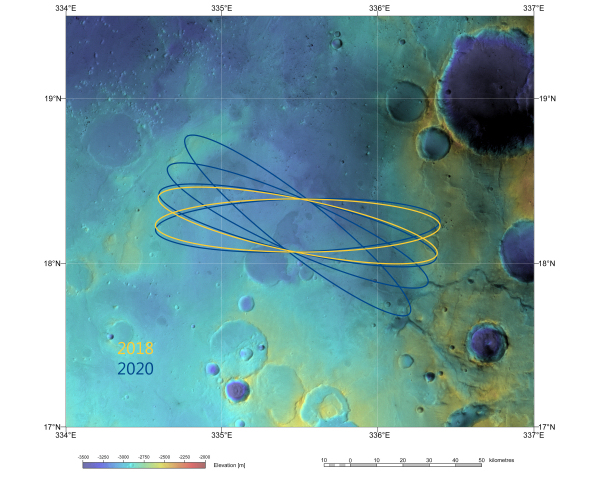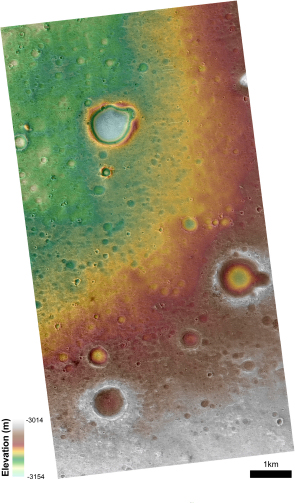Oxia Planum
(Oxia Planum is one of three candidate landing sites being studied for the ExoMars 2020 mission. The other sites are Aram Dorsum and Mawrth Vallis. Hypanis Vallis was considered until 2015 - it was downselected at the Third Landing Site Selection Workshop.)
The Oxia Planum site (18.20°N, 335.45°E) lies a few hundred kilometres to the south west of Mawrth Vallis, to the east of the Chryse Planitia lowlands. The region is characterised by ancient highland cratered terrains that become increasingly eroded towards the highland-lowland boundary.
 |
| ExoMars landing ellipses in Oxia Planum. Credit: ESA/DLR/FU Berlin & NASA MGS MOLA Science Team |
There are few large impact craters in this region, but various outflow channels dissect the area as they converge toward Chryse Planitia. Several alluvial fans or deltas have been preserved at the outlets of valleys, often extending into 100-km-wide basins.
 |
| Detail of region in Oxia Planum. Credit: NASA/MRO/HiRISE/Oxia Planum Team/LSSWG |
The candidate landing site area in Oxia Planum is located inside a shallow basin, at the outlet of the Coogoon Valles system. The region was chosen to include extensive, layered exposures rich in iron and magnesium phyllosilicates. These probably represent the south-western expansion of the clay-rich deposits around Mawrth Vallis. The ancient crust underwent intense erosion until 3.6 billion years ago, although the phyllosilicate-bearing rocks have been exposed only recently.
As is the case with Mawrth Vallis, a dark, possibly volcanic, material overlies the clay-rich unit, and appears to have been eroded only recently – within the last 100 million years. There is no evidence for thermal or metamorphic alteration of the clay-bearing deposits.
Single, sinuous, deep valleys, hundreds of kilometres long, are present within and around the ellipse. However, these valleys are not part of a well-developed network, and seem to be the result of sapping or local ground flow processes.
The eastern part of the Oxia Planum candidate site includes the relic of a 15-km-wide, 21-km-long, fan-shaped deposit. This flat feature has many divergent, finger-like terminations, and shows no obvious channel; it may represent an ancient delta or an alluvial fan.
The potential for biosignature preservation in this area is similar to that of Mawrth Vallis. The ancient, clay-rich outcrops may have formed in aqueous conditions that could have hosted micro-organisms and the fine-grained sediments could have preserved evidence of their existence.
Like Mawrth Vallis, the main scientific concern for this site relates to the lack of precise information regarding the geologic context and origin of the clay-bearing unit. However, the phyllosilicate deposits are seen as the key to the study of aqueous activity on early Mars and the search for evidence of habitable environments early in the planet’s history.
The Oxia Planum landing ellipse (major-axis is 104 km, minor-axis is 19 km) has no elevation problems and contains very few topographic obstacles or challenging slopes. The dust coverage is very low in this area and the surface is generally smooth.
Further details about the landing site selection process can be found in the report of the Landing Site Selection Working Group: Recommendation for the Narrowing of ExoMars 2018 Landing Sites.



